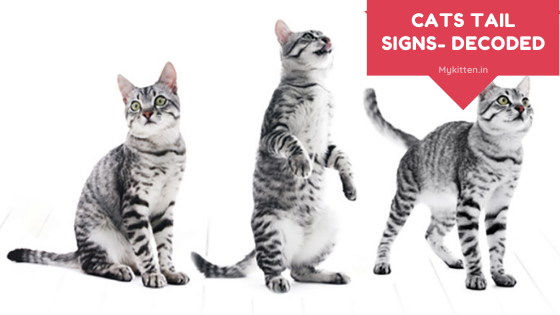Cat Tail Signs: Understand Kitten Behavior , Body Language & Avoid Problems
Why Understanding Your Cat's Communication Matters
Did you know cats show their feelings mostly through body language? Their tails can send up to 30 different messages. Knowing what these signs mean can help stop problems like aggression or anxiety in kittens. Every little movement of their tail tells you something about how they’re feeling, but many owners miss these hints.
This guide will teach you how to read your cat’s tail movements. It will also show you how to use kitten’s body language to make your relationship stronger and more peaceful.
Cats may seem mysterious, but their cat tail signs and kitten’s body language show their feelings every day. These silent signals are key for your cat’s health and your bond. Misreading them can cause stress or confusion for both of you.
Understanding Cat Tail Signs - Their Way
A cat tail signs best expresses what they are feeling. All you need is to `pay close attention to your feline friend. Even if you are searching for some particular signs that might lead you to what your cat is up to, you will eventually end up confused.
Ever wondered how cats express their feelings? Or tried to figure out what is exactly going on inside your cat’s mind?
Naturally, all cat owners do not come with the skill of understanding their pets on their own. They need some indications that help in knowing their kitty better. As soon as you master the art of studying and observing your cat’s tail, you are almost there to be the best cat owner. This not only helps in understanding their mental state but lets you resolve their problems related to mental or physical health.
It will become ultimately easy for you to know the emotions of your cats and understand their mood swings. Let us have a look at a complete guide about cat’ tail movements to let you get closer to your pet.
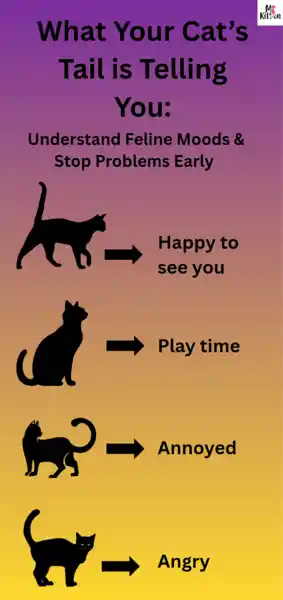
Understanding Signals of Cats Tail Signs- Decoded
Types of Cat Tails Signs
Upright and Quivering: Signs of Excitement
An upright tail with a curled tip signals confidence. When it quivers, this is a joyful greeting. Your cat shows love when their tail trembles as you enter the room. This is their happy dance!
When your kitty is roaming about with an upright tail, you just need to learn that it means that your cat is happy and feeling confident. And that is what we all need, a happy cat. To keep that going and ensuring that your pet stays contented and happy always, you need to plan out time for playing with them or providing them with snuggly cuddles. Simple treats and perks after they obey you or act as a good kitty.
Low and Swishing: Warning Signals
A tail held low and swaying side-to side means irritation. This motion warns you to give them space. Children or new pets may trigger this reaction, so watch for this sign to prevent mishaps.
Question mark like
This peculiar shape of the tail represents a friendly cat mood. You get to witness an amiable side of your pet that in cats, is a rare thing. It is suggested that whenever you find your cat with a curled-up tip tail, then just simply give your hand to them so that they can sniff it and you can even show them some petting and extra care. Also, this type of tail can act as an invitation to the guests at your place.
Straight, but down
This one is the most important one to learn. Such a shape of the tail not only expresses a bad mood of the kitty but tells you that your cat is feeling aggressive. And as we all know, a cat in a bad mood is a dangerous and difficult one to handle. Such agitated cats can scratch you or mess with your delicate stuff. Whenever you spot a cat with such a tail, make sure you engage her in your petting and try to bring her back to normal by removing the stuff irritating her.
Curled up under the body
Whenever you spot a kitty sitting aside with such a curled up tail around her body, learn that they are feeling nervous or maybe sometimes, submissive. A cat can be shy and timid in a strange environment or whenever they need attention from you. In such a case, all you can provide them with is attention and extra care.
Puffed Tails: Fear and Aggression Indicators
A puffed tail—fluffed to double its size reveals fear or defensiveness. Your cat feels threatened by loud noises or unfamiliar guests. Offer a safe spot for them to retreat.
When cats turn their tails into such a shape, they are feeling scared and angry. Cats tend to get scared whenever there is some sudden movement or when they get surprised. Even when they are shouting at you and yelling at other felines, their fur becomes puffy and the tail gets puffed up. In such a case, all that you can do is leave them alone for some time. Doing so will provide them some mental space so that everything gets back to normal.
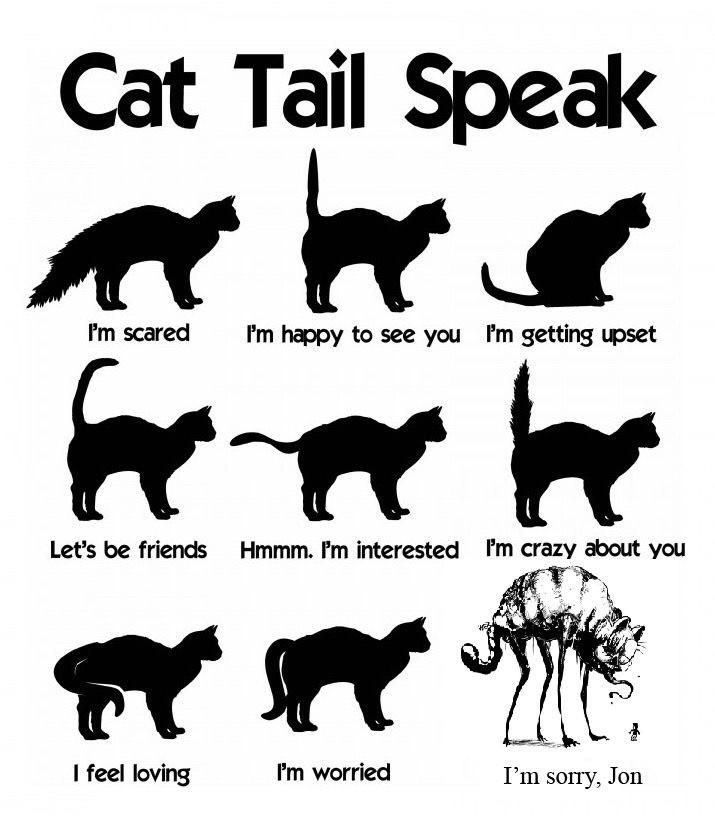
Wagging tail
You might notice such type of tail movement mostly in dogs. As you spot your cat moving her tail swiftly side to side, just know that either they are fearing something or are aggressive. Such an attitude might get you confused about what is on their mind. The only way to get them calmed down is to leave them where they are and never force your cuddles on them. Trying to cuddle up with an angry cat would result in increasing their anger more.
Gentle swaying tail
This tail movement is spotted only when the cats are focusing on something and are planning to pounce on it. This type of swaying is generally identified when they are hunting or are about to grab prey. This type of tail movement is found when you try to teach them a trick or command them to follow your actions. In such a focused mood, you should just leave them where they are and let them grab what they want to. Failing to do so and interrupting in between their focus will lead to them getting angry over you.
The tail’s tale
Now when you have come across all types of tail shapes and movements, you will find it easy to observe their state of mind throughout your life with your loving pet. Such tail gestures help you get to the nerve of the problem they are facing. In cats, it is quite difficult to know exactly what they are thinking or are about to react. Just take a little time to observe and learn and you are good to go! Learning these different tails’ movements and erections are not difficult to memorize. You will get to understand them quickly as you start observing your cat closely.
Subtle Movements That Speak Volumes
Gentle tip twitches show focus, like during playtime. A tail draped around your leg is a bond gesture. These small cues, paired with kitten’s body language, build a deeper connection.

Cat Tail Signs: The Ultimate Guide to Feline Emotions
The Silent Language of Felines
Cats talk through posture, ear movements, and tail positions. Their tails tell stories – twitching means excitement, while a low, stiff tail warns of frustration. Watching these cues helps you meet their needs before problems start.
Building a Stronger Bond Through Understanding
When you notice your cat’s tail language, you show you care. For example, a relaxed cat with a loose tail shows trust. Recognizing these moments strengthens your bond. In urban Indian homes, where cats often live indoors, this understanding is even more important for their comfort.
How Communication Affects Your Cat’s Wellbeing
Ignoring your cat’s signals can cause anxiety or aggression. A flick of the tail or flattened ears might signal stress. By learning their language, you create a calm environment. Happy cats with clear communication are less likely to develop behavioral problems like aggression or litter box avoidance.
Key Takeaways
- Cat tails act as emotional barometers, signaling happiness, fear, or irritation through specific movements.
- Ignoring tail signals can lead to unaddressed stress, leading to behaviors like scratching or litter box avoidance.
- Kitten’s body language develops rapidly, with tail signals becoming clear by 12 weeks of age.
- Learning cat tail signs reduces misunderstandings, strengthening trust between you and your pet.
- Combining tail observations with ear, eye, and posture cues provides a full picture of your cat’s state.
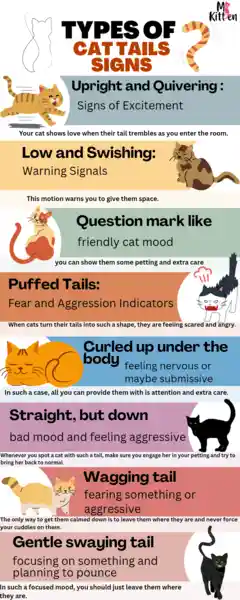
Decoding the Different Positions of Your Cat's Tail Signs
Understanding cat tail signs is key to interpreting your kitten’s body language. Each position signals a distinct emotion or intention. When your cat holds its tail upright with a question mark curve, this friendly gesture shows confidence and happiness. Imagine your kitten approaching you with this posture—it’s a clear invitation for interaction.
A horizontal tail signals curiosity. Watch how your cat freezes mid-step while staring out the window, tail level with its body. This position reveals focus on something intriguing. If the tail tucks low or between the legs, your kitten may feel anxious or insecure, usually in new environments or after adoption.
When resting, a curled tail around the body offers comfort and warmth. This is common in colder climates like northern India’s winters. Rapid tail thrashing warns of irritation, while slow swishing might mean your cat is stalking a toy. These subtle differences help you anticipate reactions and avoid mishaps.
Observe how these cat tail signs combine with ear twitches or eye expressions to form a full picture of your kitten’s state. By noticing these details daily, you can adjust playtime or calm stressful situations early.
We also have breeds like Persian, Ragdoll, Maine Coon, Siamese, Exotic Shorthair, Bengal, and British Shorthair.
The Complete Picture: Beyond the Cat Tail Signs
Reading your kitten’s body language is more than just looking at their tail. Their ears, eyes, and posture also tell a story. By combining these signals, you can understand your cat’s feelings and needs.
Ear Positions and What They Reveal
Cats use their ears like tiny radar dishes. Ears forward show curiosity. Flattened ears pressed sideways mean fear or aggression. In homes with many pets, noticing these changes can stop fights. Ears turning backward mean they’re listening or sensing danger.
Eye Contact and Pupil Dilation
Direct stares between cats can be tense. But slow blinking from your cat means they trust you. Return these blinks to bond deeper. Widened pupils might show excitement or fear. Look at their tail and ear movements to understand the situation.
Body Posture Meanings
A relaxed cat sprawled on their side is happy. But an arched back with fluffed fur warns of aggression. A crouched body with a low tail suggests playfulness or stress. Watch how their body curves and moves with their tail to avoid misunderstandings.
Combining Multiple Cues
Never rely on just one signal. A twitching tail tip and forward ears show playful energy. But with flattened ears and a low posture, it warns of stress. Pairing kitten’s body language clues with their tail helps you respond right. Whether to engage or give them space.
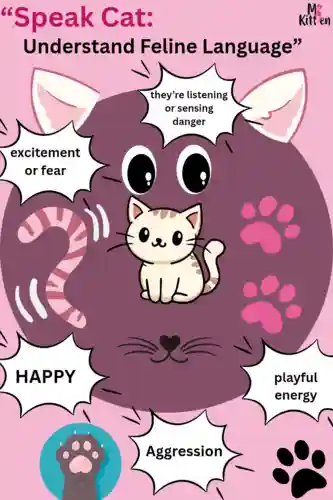
Your Kitten's Body Language: A Developmental Perspective
Understanding your kitten’s communication is crucial for a strong bond. From birth to adulthood, their body language changes as they learn to express needs and feelings. Early development shapes their interactions, affecting the behaviors you see every day.
How Kittens Learn to Communicate
Newborns use sounds and basic movements to show hunger or distress. By three to four weeks, they start to mimic their mother’s tail and ear movements during play. They watch their mother and siblings to learn how to send signals, like a raised tail for play or flattened ears as warnings.
Age-Related Changes in Body Language
Young kittens are full of playful pounces and exaggerated tail flicks. By six to eight months, these actions become more controlled, like adult cats. Seeing a kitten’s wide-legged stance turn into a relaxed posture shows their growing communication skills.
Socialization’s Impact on Expression
Kittens that experience different things between two to seven weeks have clearer body language. Limited socialization can lead to behavioral issues, like too much hissing or hiding. Early positive interactions help them show comfort and confidence, reducing fear-driven aggression.
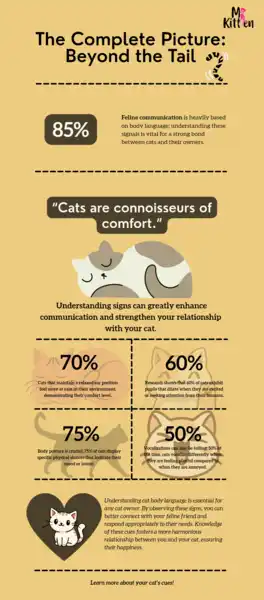
The Complete Picture: Beyond the Tail
Reading your kitten’s body language is more than just looking at their tail. Their ears, eyes, and posture also tell a story. By combining these signals, you can understand your cat’s feelings and needs.
Ear Positions and What They Reveal
Cats use their ears like tiny radar dishes. Ears forward show curiosity. Flattened ears pressed sideways mean fear or aggression. In homes with many pets, noticing these changes can stop fights. Ears turning backward mean they’re listening or sensing danger.
Eye Contact and Pupil Dilation
Direct stares between cats can be tense. But slow blinking from your cat means they trust you. Return these blinks to bond deeper. Widened pupils might show excitement or fear. Look at their tail and ear movements to understand the situation.
Body Posture Meanings
A relaxed cat sprawled on their side is happy. But an arched back with fluffed fur warns of aggression. A crouched body with a low tail suggests playfulness or stress. Watch how their body curves and moves with their tail to avoid misunderstandings.
Combining Multiple Cues
Never rely on just one signal. A twitching tail tip and forward ears show playful energy. But with flattened ears and a low posture, it warns of stress. Pairing kitten’s body language clues with their tail helps you respond right. Whether to engage or give them space.
Vocalizations That Complement Body Language
Cats communicate through sounds and body language. Watch how your kitten’s meows, chirps, and purrs match their posture. For instance, purring usually means they’re comfortable, but only when they’re relaxed too. Look for a loose tail or slow blinks to confirm this. But, if your kitten purrs while shaking or avoiding you, they might be stressed or in pain.
Trills mean your kitten is curious, often seen when they approach with ears up and tail high. Low, repetitive meows with a swishing tail might show frustration. This is a sign of potential behavioral issues if not addressed.
Chattering at windows with a twitching tail means they’re excited to hunt. But, hissing with ears back and fur puffed means they need space right away.
Understanding both sounds and posture helps you know what your kitten needs. A friendly greeting has an upright tail and a chirpy meow. Fearful sounds come with ears down or a tucked body. Learning this helps solve problems early, building trust and avoiding misunderstandings.
Common Behavioral Problems in Kittens and Their Signals
Spotting behavioral problems in kittens starts with watching their kitten’s body language. Small signs like tail movements or ear positions can warn of issues early. Let’s look at important signs to watch for. At Mykitten our Cat Breeders guide you on these issues.
Scratching Furniture: The Why Behind the Behavior
Scratching is natural, but it can damage furniture. Before they scratch, kittens may stretch fully upright. They might have a stiff tail and knead the air with their paws. These kitten’s body language signs warn of damage, giving you time to guide them to a scratching post.
Litter Box Avoidance: Body Language Clues
If your kitten hesitates near the litter box, it’s a warning sign. They might show a tucked tail and wide eyes. Backing away, excessive pawing at the litter, or flattened ears are all signs of discomfort. Often, pain or stress, like in multi-cat homes, causes this.
Aggression During Play: Reading the Signs
Playtime bites or swats are usually gentle. But, if aggression grows, kittens show rigid posture and tail lashing. Look for flattened ears or dilated pupils. These signs mean they’re moving from play to real aggression, needing quick action.
Separation Anxiety: Recognizing the Symptoms
Excessive meowing, destroyed window sills, or frantic greetings when you return are signs of separation anxiety. These behavioral problems in kittens often come with frantic tail flicks or overgroomed fur patches.
Effective Solutions for Kitten Behavior Challenges
Start by watching cat tail signs to catch problems early. If your kitten’s tail twitches before they scratch, it’s a sign. Place vertical scratching posts near furniture with sisal or cardboard textures. Reward them with treats for using these posts.
Use double sided tape on furniture to stop scratching until they learn better. This method is temporary and helps them find the right spot to scratch.
For litter box issues, look for hesitant or tail flicking behavior. Use unscented clumping litter and clean the boxes every day. In small homes, stackable litter stations in quiet spots are a good solution. Make sure there’s one litter box per cat plus one extra to reduce stress.
Aggressive play is common but can be managed. If your kitten’s tail puffs or lashes, stop play right away. Use wand toys like Da Bird Feather Teaser to keep play safe. Play for 15 minutes twice a day, matching their natural activity peaks.
Puzzle feeders are great for keeping them mentally active. This helps channel their energy into fun challenges.
Separation anxiety can be seen in frantic tail movements or hiding. Start by making leaving calm for your kitten. Leave catnip toys or use Feliway diffusers to calm them. Window perches with bird feeders keep them entertained when you’re away. Gradually increase the time you’re away to build their confidence.
Conclusion: Becoming Fluent in Your Cat's Language
Learning about your cat’s language starts with understanding cat tail signs and kitten’s body language. Each movement of their tail tells you how they feel. Spotting these signs early can prevent behavioral problems in kittens from getting worse.
A raised tail means your cat is happy. But a low swish can warn of irritation. Paying attention to these signs builds trust and avoids misunderstandings. Every part of your cat’s body communicates. Look at tail movements, ear tilts, eye dilation, and sounds for the full story. A twitching tail might show focus or stress, so consider the whole picture.
This approach helps you meet your cat’s needs correctly. Learning doesn’t end here. Watch how your kitten’s behavior changes as they grow. Early socialization and consistent responses shape their behavior. If problems continue, get help from certified cat behaviorists in India. They can offer effective solutions.
Mastering your cat’s language strengthens your bond. As more homes in India welcome cats, this knowledge ensures peace. By understanding tails, postures, and sounds, you create a safe space for both you and your cat to flourish.
FAQ
What do different cat tail positions mean?
A cat’s tail tells us a lot about their mood. An upright tail means they’re happy and confident. A low or swishing tail shows they’re upset or annoyed. A puffed tail means they’re scared or angry.
How can I tell if my kitten is happy?
A happy kitten has an upright, relaxed tail. They might purr and play a lot. They also come to you with their tail up, showing they’re safe and happy.
What signs indicate my kitten may have behavioral problems?
Behavioral issues in kittens include too much aggression, avoiding the litter box, and damaging furniture. They might also hide or meow too much. Watching their body language can help spot these problems early.
How do I differentiate between play aggression and real aggression?
Play aggression looks like relaxed body language, with ears forward and a playful look. True aggression shows a puffed tail, big pupils, and flat ears. This means they’re really scared or upset.
Are there effective solutions for scratching behavior?
Yes, there are ways to stop scratching furniture. Give them scratching posts and use deterrents on furniture. Reward them for scratching the right places to encourage good behavior.
How does socialization impact my kitten’s ability to communicate?
Socialization helps kittens communicate better. Kittens that meet different people and places learn to express themselves clearly. This reduces the chance of behavioral problems later.
Read More about Guide to buying kittens in India

